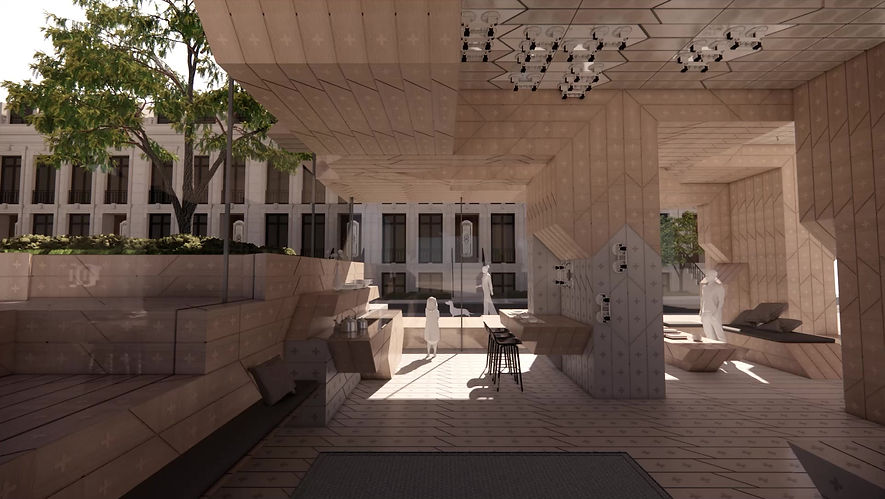Diffusive Habitats
Type
Masters Thesis
Description
Diffusive Habitats is a resilient architectural system that builds upon the juncture of distributed robotics, reinforcement learning, and digital platforms to reimagine the way we conceive and inhabit architecture. Challenging traditional praxis, the project is conceived under the premise of constant spatial reconfiguration, non-linear life cycles, and distributed ownership. And thus, via the interplay of its algorithmic, mechatronic, and material research, Diffusive Habitats critically explores the idea of a living architectural system capable of self-assessment, organization, and improvement.
Authors
Eric Hughes,
Lia Papoutsi,
Faizunsha IG,
and
Sergio Mutis
Role
Within the Diffusive Habitats’ team, I led efforts on robotics research, simulation and control, multi-agent intelligence, material research prototyping and testing, and video production. Yet, all team members contributed to every aspect of the project.
Institution
Bartlett, UCL
Location
London, UK
Honors
A' Design Awards
Bartlett AD
Gold Medal,
Architecture Masterprize
London Inernational Creative Awards
Tutors
Tyson Hosmer
Octavian Gh.
Philipp Siedler
Baris Erdincer
Ziming He
Years
2021-2022

1. Case Study Illustration

Adapting to Changing Needs
This case-study in Brixton, London, UK, illustrates the vision for the system. First, people meet, select a plot, and collectively design their habitat on the DH platform. Second, their habitat is fabricated and assembled on-demand by a swarm of collaborative robots. Third, the community triggers spatial reconfigurations for temporary activities and gradual growth. Finally, these reconfigurations continue over seasonal timeframes, adapting to changing environmental conditions.
2. Algorithmic Research

Generative Space Planning
Diffusive Habitats uses two key algorithms: (1) Spatial Planner, which generates 3D masks using machine learning agents that expand and negotiate space occupation, and (2) Spatial Assembly, which fits material units, like puzzle pieces, within the 3D masks to create the physical structure.
3. Material Research

Material Unit Detailing
Diffusive Habitats allows for the use of multiple materials, which come together in diverse shapes and geometries to form a spatial system. Unit types include simple building blocks, magnetic surface charging stations, services + reinforcement units, and custom solar panels, among others.

Material Prototyping
The main units of the system were methodically prototyped and tested alongside robotic iterations, testing for synergies between fabrication method, materiality, shape, weight, and robotic compatibility.
4. Robotic Research

Robotic Design
The project's robotic design was conceived by analyzing, merging, and furthering precedent state-of-the-art robotic morphologies. At its core, the design pursues simplicity and collaboration, while minimizing motor forces and torques.

Robotic Testing
Systematic experimentation (gauging the capabilities and limitations of the robotic prototypes) proved fundamental for prototype evolution, revealing the vast flexibility and unforeseen capabilities of collaborative behaviors.

Motion Capture
The projects robots do not have any sensors, initially guided exclusevely by a digital simulation. Later, 3D-tracking with Unity and Optitrack was introduced to identify discrepancies between the simulation and the physical world.
5. Intelligence Research

Multi-Agent Machine Learning
The project utilizes a game-based research framework to develop its robotic intelligence. This arena illustrates the process by which AI is trained to compete against humans and hardcoded algorithms within that framework.

Applied Intelligence - Skylight Simulation
The framework’s best performing strategies can be applied to larger scale reconfigurations. For instance, this 6-robot simulation features AI-based pass behaviors, pathfinding algorithm sequences, and human-derived “turn” coordination.

Applied Intelligence - Reconfiguration Studies
Likewise, this intelligence can be applied to the project’s physical prototypes and physical studies, revealing both the potential and limits of the current state of development.

Reconfiguration Studies Catalog
Given the nature and flexibility of Diffusive Habitats' system, material can be reconfigured into an array of shapes to serve diverse functions and account for changing needs.

Reconfiguration Studies - Arch
Physical reconfiguration studies gauge constraints and inform the computational models. For instance, this 50-unit arch could not be assembled as simulated, revealing much about the sequencing and reinforcement of cantilevering structures.
6. Architectural Experience

Machine Learning
Altogether, Diffusive Habitats presents a novel way to experience architecture. From the rigid objects of traditional construction, to dynamic ecologies of adaptation, where spaces modify to meet the inhabitants needs over time.

Machine Learning
At a larger scale, these habitats merge into living eco-systems, facilitating and accelerating self-assessment, organization, and improvement for a better model of human inhabitation.
Voiceover Overview - 5min
